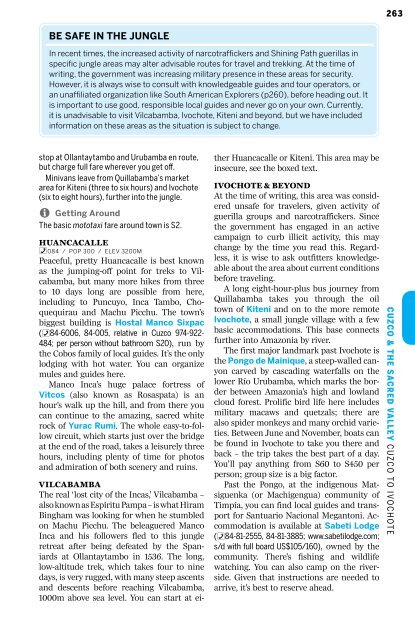peru-8-cuzco-sacred-valley
Create successful ePaper yourself
Turn your PDF publications into a flip-book with our unique Google optimized e-Paper software.
263<br />
BE SAFE IN THE JUNGLE<br />
In recent times, the increased activity of narcotraffickers and Shining Path guerillas in<br />
specific jungle areas may alter advisable routes for travel and trekking. At the time of<br />
writing, the government was increasing military presence in these areas for security.<br />
However, it is always wise to consult with knowledgeable guides and tour operators, or<br />
an unaffiliated organization like South American Explorers (p260), before heading out. It<br />
is important to use good, responsible local guides and never go on your own. Currently,<br />
it is unadvisable to visit Vilcabamba, Ivochote, Kiteni and beyond, but we have included<br />
information on these areas as the situation is subject to change.<br />
stop at Ollantaytambo and Urubamba en route,<br />
but charge full fare wherever you get off.<br />
Minivans leave from Quillabamba’s market<br />
area for Kiteni (three to six hours) and Ivochote<br />
(six to eight hours), further into the jungle.<br />
8 Getting Around<br />
The basic mototaxi fare around town is S2.<br />
HUANCACALLE<br />
%084 / POP 300 / ELEV 3200M<br />
Peaceful, pretty Huancacalle is best known<br />
as the jumping-off point for treks to Vilcabamba,<br />
but many more hikes from three<br />
to 10 days long are possible from here,<br />
including to Puncuyo, Inca Tambo, Choquequirau<br />
and Machu Picchu. The town’s<br />
biggest building is Hostal Manco Sixpac<br />
(%84-6006, 84-005, relative in Cuzco 974-922-<br />
484; per person without bathroom S20), run by<br />
the Cobos family of local guides. It’s the only<br />
lodging with hot water. You can organize<br />
mules and guides here.<br />
Manco Inca’s huge palace fortress of<br />
Vitcos (also known as Rosaspata) is an<br />
hour’s walk up the hill, and from there you<br />
can continue to the amazing, <strong>sacred</strong> white<br />
rock of Yurac Rumi. The whole easy-to-follow<br />
circuit, which starts just over the bridge<br />
at the end of the road, takes a leisurely three<br />
hours, including plenty of time for photos<br />
and admiration of both scenery and ruins.<br />
VILCABAMBA<br />
The real ‘lost city of the Incas,’ Vilcabamba –<br />
also known as Espíritu Pampa – is what Hiram<br />
Bingham was looking for when he stumbled<br />
on Machu Picchu. The beleaguered Manco<br />
Inca and his followers fled to this jungle<br />
retreat after being defeated by the Spaniards<br />
at Ollantaytambo in 1536. The long,<br />
low-altitude trek, which takes four to nine<br />
days, is very rugged, with many steep ascents<br />
and descents before reaching Vilcabamba,<br />
1000m above sea level. You can start at either<br />
Huancacalle or Kiteni. This area may be<br />
insecure, see the boxed text.<br />
IVOCHOTE & BEYOND<br />
At the time of writing, this area was considered<br />
unsafe for travelers, given activity of<br />
guerilla groups and narcotraffickers. Since<br />
the government has engaged in an active<br />
campaign to curb illicit activity, this may<br />
change by the time you read this. Regardless,<br />
it is wise to ask outfitters knowledgeable<br />
about the area about current conditions<br />
before traveling.<br />
A long eight-hour-plus bus journey from<br />
Quillabamba takes you through the oil<br />
town of Kiteni and on to the more remote<br />
Ivochote, a small jungle village with a few<br />
basic accommodations. This base connects<br />
further into Amazonia by river.<br />
The first major landmark past Ivochote is<br />
the Pongo de Mainique, a steep-walled canyon<br />
carved by cascading waterfalls on the<br />
lower Río Urubamba, which marks the border<br />
between Amazonia’s high and lowland<br />
cloud forest. Prolific bird life here includes<br />
military macaws and quetzals; there are<br />
also spider monkeys and many orchid varieties.<br />
Between June and November, boats can<br />
be found in Ivochote to take you there and<br />
back – the trip takes the best part of a day.<br />
You’ll pay anything from S60 to S450 per<br />
person; group size is a big factor.<br />
Past the Pongo, at the indigenous Matsiguenka<br />
(or Machigengua) community of<br />
Timpía, you can find local guides and transport<br />
for Santuario Nacional Megantoni. Accommodation<br />
is available at Sabeti Lodge<br />
(%84-81-2555, 84-81-3885; www.sabetilodge.com;<br />
s/d with full board US$105/160), owned by the<br />
community. There’s fishing and wildlife<br />
watching. You can also camp on the riverside.<br />
Given that instructions are needed to<br />
arrive, it’s best to reserve ahead.<br />
Cuzco & the Sacred Valley T C H u E zC H O I K TO E T I VO H E C J H U OT N G E L E


